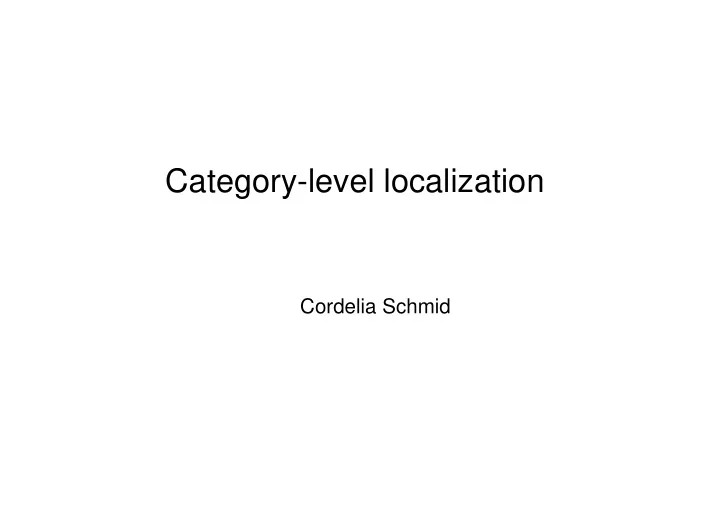

Category-level localization g y Cordelia Schmid Cordelia Schmid
Recognition Recognition • • Classification Classification – Object present/absent in an image – Often presence of a significant amount of background clutter • Localization / Detection – Localize object within the frame – Bounding box or pixel- level segmentation
Pixel-level object classification Pixel level object classification
Difficulties Difficulties • Intra-class variations Intra class variations • Scale and viewpoint change • Multiple aspects of categories
Approaches Approaches • Intra-class variation Intra class variation => Modeling of the variations, mainly by learning from a large dataset for example by SVMs large dataset, for example by SVMs • Scale + limited viewpoints changes • Scale + limited viewpoints changes => multi-scale approach or invariant local features • Multiple aspects of categories => separate detectors for each aspect, front/profile face, > separate detectors for each aspect front/profile face build an approximate 3D “category” model
Approaches Approaches • Localization (bounding box) Localization (bounding box) – Hough transform – Sliding window approach Sliding window approach • Localization (segmentation) ( g ) – Shape based – Pixel-based +MRF – Segmented regions + classification
Hough voting • Use Hough space voting to find objects of a class g p g j • Implicit shape model [Leibe and Schiele ’03,’05] y y Learning Learning • Learn appearance codebook – Cluster over interest points on training s s images x x y y y y • Learn spatial distributions – Match codebook to training images – Record matching positions on object – Centroid + scale is given g s s x x Spatial occurrence distributions Recognition Recognition Matched Codebook Interest Points Interest Points Probabilistic Probabilistic Entries Voting
Hough voting Hough voting [O [Opelt, Pinz,Zisserman, ECCV 2006] lt Pi Zi ECCV 2006]
Localization with sliding window Localization with sliding window Training Positive examples Negative examples Description + Learn a classifier
Localization with sliding window Localization with sliding window T Testing at multiple locations and scales ti t lti l l ti d l Find local maxima non-maxima suppression Find local maxima, non-maxima suppression
Sliding Window Detectors Detection Phase Scan image(s) at all scales and locations Scale-space pyramid ` Extract features over windows Run window classifier at all locations Detection window Fuse multiple detections in 3-D position & scale space Object detections with bounding boxes 11
Haar Wavelet / SVM Human Detector Haar Wavelet / SVM Human Detector Haar wavelet descriptors training 1326-D descriptor Training set (2k positive / 10k negative) S Support t vector machine test test d descriptors i results Multi-scale search Test image 12 [Papageorgiou & Poggio, 1998]
Which Descriptors are Important? c esc p o s a e po a 32x32 descriptors 16x16 descriptors Mean response difference between positive & Mean response difference between positive & negative training examples Essentially just a coarse-scale human silhouette template!
Some Detection Results
PASCAL VOC dataset - localization • 20 object classes (aeroplane, bicycle, bird, etc.) • Bounding box annotations for training and evaluation • Viewpoint information : front, rear, left, right, unspecified • Other information : truncated, occluded, difficult
PASCAL dataset PASCAL dataset
PASCAL dataset PASCAL dataset
Evaluating localization with bounding boxes Evaluating localization with bounding boxes
Evaluating localization with bounding boxes Evaluating localization with bounding boxes Evaluation Evaluation
Recommend
More recommend